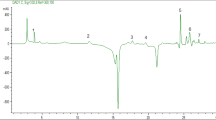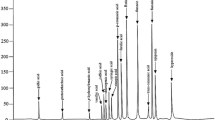Abstract
The antioxidant activities of vidarikand (Pueraria tuberosa), shatavari (Asparagus racemosus) and ashwagandha (Withania somnifera) extracts (aqueous and ethanolic) were evaluated and compared with BHA using β-carotene bleaching assay, DPPH assay and Rancimat method. Phenolic contents of ethanolic extracts of herbs were high compared to their aqueous extracts. The ethanolic extracts showed more antioxidant activity (β-carotene–linoleic acid model system) than their aqueous counterparts. In DPPH system also, ethanolic extracts were superior to that of aqueous extracts. The ethanolic extracts of the herbs were more effective in preventing the development of the peroxide value and conjugated diene in ghee compared to their aqueous extracts. Ethanolic extracts of herbs showed the higher induction period as compared to their aqueous counter parts in the Rancimat. Antioxidant activity of the herbs decreased in the order vidarikand > ashwagandha > shatavari. Thus, the ethanolic extract of vidarikand was having the maximum antioxidant activity among all the herbs.

Similar content being viewed by others
References
AOAC (1995) Official methods of analysis of AOAC International, 16th edn, Vol. II pp 988
Baratto MC, Tattini M, Galardi C, Pinelli P, Romani A, Visiolid F, Basosi R, Poqni R (2003) Antioxidant activity of Galloyl quinic derivatives isolated from Pistacialentiscusleaves. Free Radic Res 37:405–412
Beta T, Nam S, Dexter JE, Sapirstein HD (2005) Phenolic content and antioxidant activity of pearled wheat and roller-milled fractions. Cereal Chem 82(4):390–393
Bhatnagar M, Sisodiya SS, Bhatnagar R (2005) Antiulcer and antioxidant activity of Asparagus racemosus WILLD and Withania somnifera DUNAL in rats. Ann. N.Y. Acad. Sci 1056:261–270
Blois MS (1958) Antioxidant determination by the use of stable free radical. Nature 181:1199–1200
Cai Y, Luo Q, Sun M, Corke H (2004) Antioxidant activity and phenolic compounds of 112 traditional Chinese medicinal plants associated with anticancer. Life Sci 74:2157–2184
Choe E, Min DB (2006) Mechanisms and factors for lipid oxidation. Compr Rev Food Sci F5:169–186
Debra L, Bemis JL, Capodice JE, Costello GC, Vorys A, Dev S (2006) A selection of prime ayurvedic plant drugs: ancient—modern concordance. Anamaya Pub, New Delhi
Espin JC, Soler-Rivas C, Wichers HJ (2000) Characterization of the total free radical scavenger capacity of vegetable oils and oil fractions using 2, 2-diphenyl-1-picrylhydrazyl radical. J Agr Food Chem 48:648–656
Frankel EN (1993) In search of better methods to evaluate natural antioxidants and oxidative stability in food lipids. Trends Food Sci Tech 4:220–225
Frankel EN, Huang SW, Prior E, Aeschbach R (1996) Evaluation of antioxidant activity of rosemary extracts, carnosol and carnosic acid in bulk vegetable oils and fish oil and their emulsions. J Sci Food Agric 72:201–208
Gillam AE, Heilbron IM, Hilditch TP, Morton RA (1931) Spectrographic data of natural fats and their fatty acids in relation to vitamin A. Biochemical J 25:30–38
Goyal RK, Singh J, Lal H (2003) Asparagus racemosus – an update. Indian J Med Res 57:408–414
IS: 3508 (1966) Indian standards, methods for sampling and test for ghee (butter fat). Bureau of Indian Standards, New Delhi
Ito N, Hirose M, Fukushima H, Tsuda T, Shirai T, Tatenatsu M (1986) Studies on antioxidants: their carcinogenic and modifying effects on chemical carcinogens. Food Chem Toxicol 24:1071–1092
Jia ZB, Tao F, Guo L, Tao GJ, Ding XL (2007) Antioxidant properties of extracts from juemingzi (Cassia tora L.) evaluated in vitro. LWT 40:1072–1077
Kahkonen MP, Hopia AI, Vuorela HJ (1999) Antioxidant activity of plant extracts containing phenolic compounds. J Agr Food Chem 47:3954–3962
Kamiloğlu O, Ercisli S, Sengül M, Toplu C, Serçe S (2009) Total phenolics and antioxidant activity of jujube (Zizyphus jujube Mill.) genotypes selected from Turkey. Afr J Biotechnol 8:303–307
Katalynic V, Milos M, Kulisic T, Jukic M (2006) Screening of 70 medicinal plant extracts for antioxidant capacity and total phenols. Food Chem 94:550–557
Kim C, Shin S, Ha H, Kim JM (2003) Study of substance changes in flowers of Pueraria thunbergiana Benth during storage. Arch Pharmacol Res 26:210–213
Marco GJ (1969) A rapid method for evaluation of antioxidants. J Am Oil Chem Soc 46:594–598
Merai M, Boghra VR, Sharma RS (2003) Extraction of antioxigenic principles from Tulsi leaves and their effects on oxidative stability of ghee. J Food Sci Tech 40:52–57
Nahak G, Sahu RK (2010) Antioxidant activity in bark and roots of Neem (Azadirachta indica) and Mahaneem (Melia azedarach). Cont J Pharm Sci 4:28–34
Nsimba R, Kikuzaki H, Konishi Y (2005) Antioxidant activity of various extracts and fractions of Chenopodium quinoa and Amaranthus spp. seeds. Food Chem 106:760–766
Othman A, Ismail A, Ghani NA, Adenan I (2007) Antioxidant capacity and phenolic content of cocoa beans. Food Chem 100:1523–1530
Pandey N, Chaurasia JK, Tiwari OP, Tripathi YB (2007) Antioxidant properties of different fractions of tubers from Pueraria tuberosaLinn. Food Chem 105:219–222
Perumal S, Becker K (2003) Antioxidant properties of various solvent extracts of total phenolic constituents from three agroclimatic origins of Drumstick tree leaves. J Agric Food Chem 51:2144–2155
Philip K, Rafat A, Muniandy S (2010) Antioxidant potential and content of phenolic compounds in ethanolic extracts of selected parts of Andrographis paniculata. J Med Plants Res 4:197–202
Presa-Owens S, Lopez-Sabater MC (1995) Shelf-life prediction of an Infant formula using an accelerated stability test (Rancimat). J Agric Food Chem 43:2879–2882
Rowan C (2000) Extracting the best from herbs. Food Eng Int 25:31–34
Sharma PV (1997). Dravyaguna Vigyan, Chowkambha Sanskrit Sansthan
Siddiq A, Anwar F, Manzoor M, Fatima A (2005) Antioxidant activity of different solvent extract of Moringa Oleifera leaves under accelerated storage of sunflower oil. Asian J Plant Sci 4:630–635
Silva FA, Borges MF, Ferreira AA (1999) Methods for the evaluation of the degree of lipid oxidation and the antioxidant activity. Quimica Nova 22:94–103
Snedecor GW, Cochran WG (1994) Statistical methods, 8th edn. Affiliated East–west Press, New Delhi
Stich HF (1991) The beneficial and hazardous effects of simple phenolic compounds. Mutat Res 259:307–324
Tanwar YS, Goyal S, Ramawat KG (2008) Hypolipidemic effects of tubers of Indian kudzu (Pueraria tuberosa). J Herbal Med Toxicol 2:21–25
Tawaha K, Alali FQ, Gharaibeh M, Mohammad M, El-Elimat T (2007) Antioxidant activity and total phenolic content of selected Jordanian plant species. Food Chem 104:1372–1378
Thomsen M (2002) Shatavari- Asparagus racemosus. http://www.phytomedicine.com.au/files/articles/shatavri.pdf, accessed on 26/04/2011
Varkey TK (2010) India’s milk production rose to 112 m tonnes last fiscal. The Economic Times. http://articles.economictimes.indiatimes.news/275788221milk-production-milk-prices-cattle-feed, accessed on 26/04/2011
Verma SK, Jain V, Vyas A, Singh DP (2009) Protection against stress induced myocardial ischemia by Indian kudzu (Pueraria tuberosa) - a case study. J Herbal Med Toxicol 3:59–63
Wagner KH, Elmadfa I (1998) Effects of tocopherols and their mixtures on the oxidative stability of olive oil and linseed oil under heating. Eur J Lipid Sci Tech 103:624–629
Zia-ur-Rehman, Salariya A, Mand HF (2003) Antioxidant activity of ginger extract in sunflower oil. J Food Sci Agr 83:624–629
Acknowledgments
This work was supported by the National Agriculture Innovation Project (component 4: Basic and strategic research C30029), Indian Council of Agricultural Research. New Delhi, India.
Author information
Authors and Affiliations
Corresponding author
Rights and permissions
About this article
Cite this article
Pawar, N., Gandhi, K., Purohit, A. et al. Effect of added herb extracts on oxidative stability of ghee (butter oil) during accelerated oxidation condition. J Food Sci Technol 51, 2727–2733 (2014). https://doi.org/10.1007/s13197-012-0781-1
Revised:
Accepted:
Published:
Issue Date:
DOI: https://doi.org/10.1007/s13197-012-0781-1




